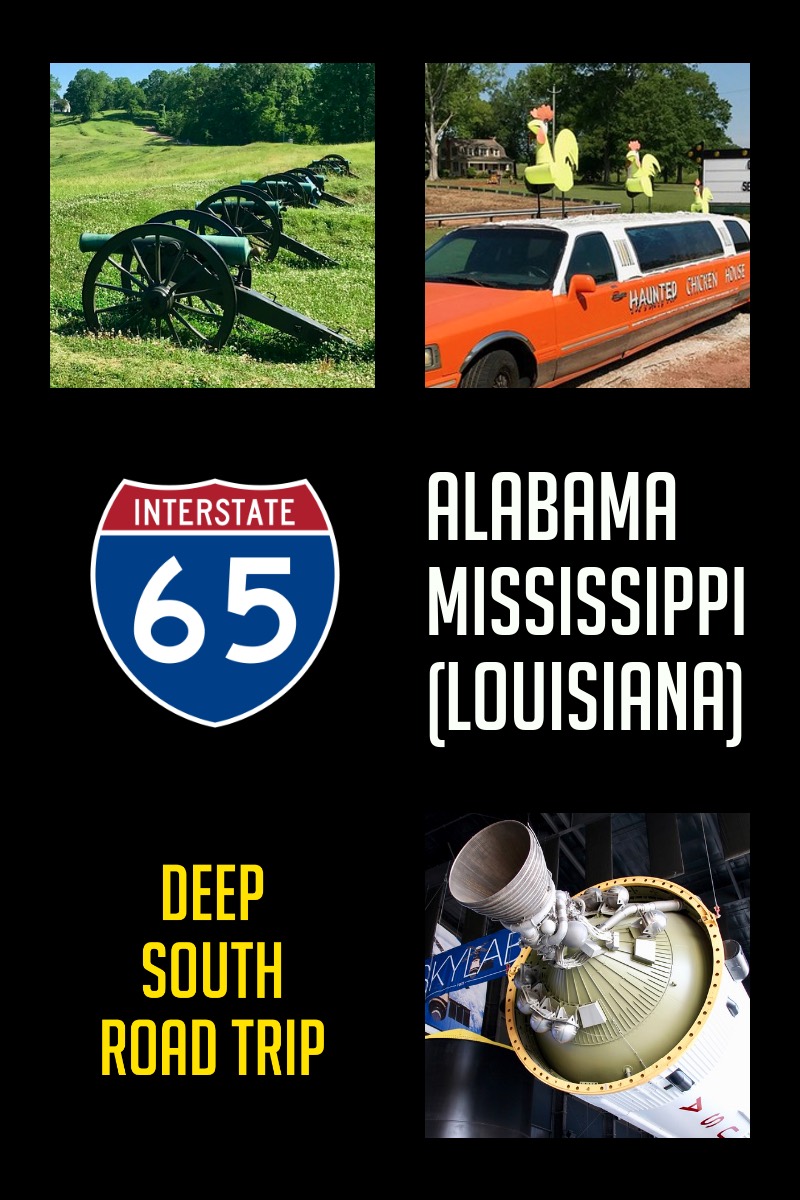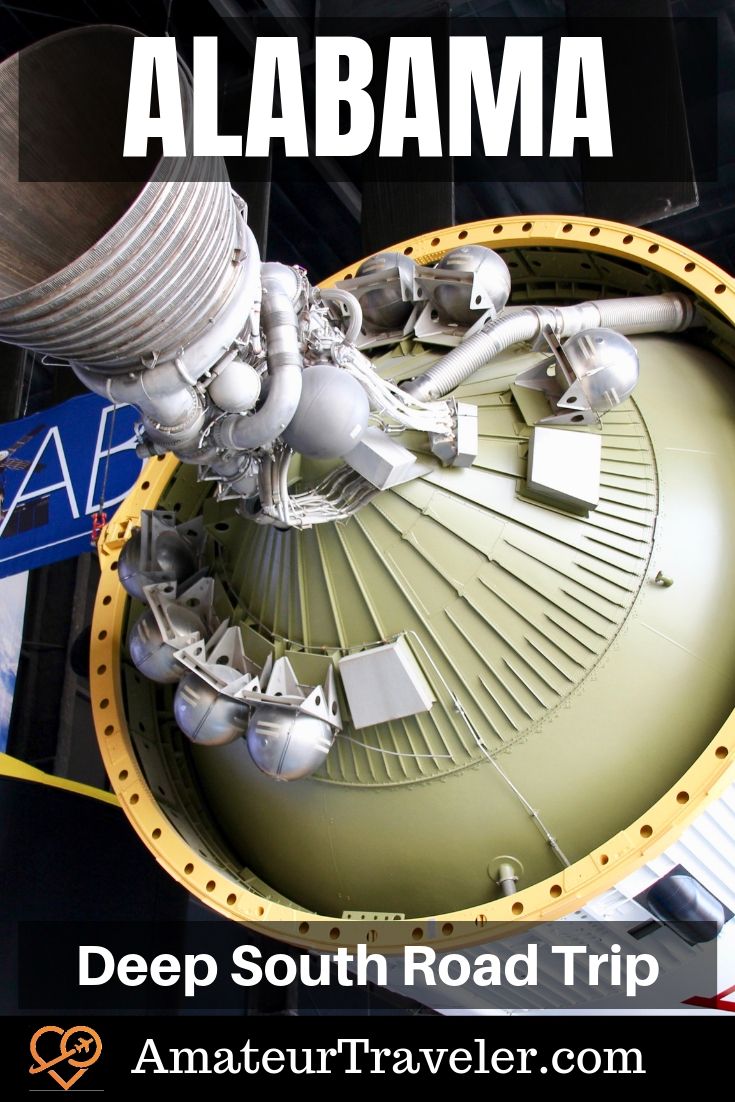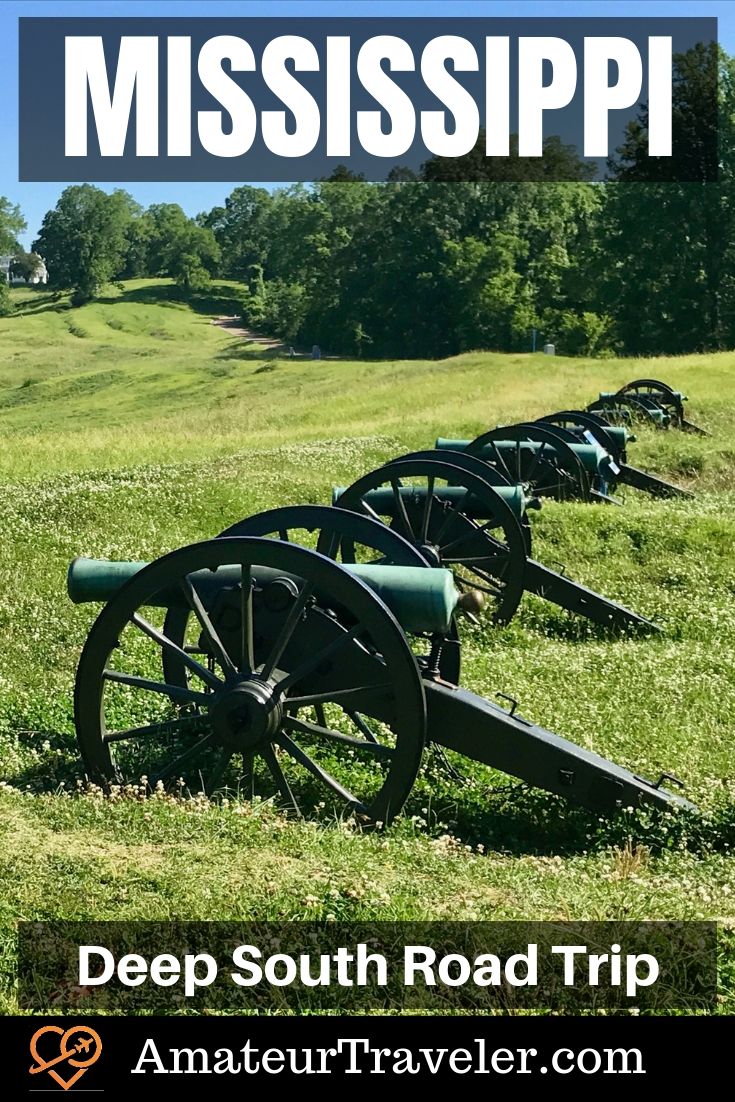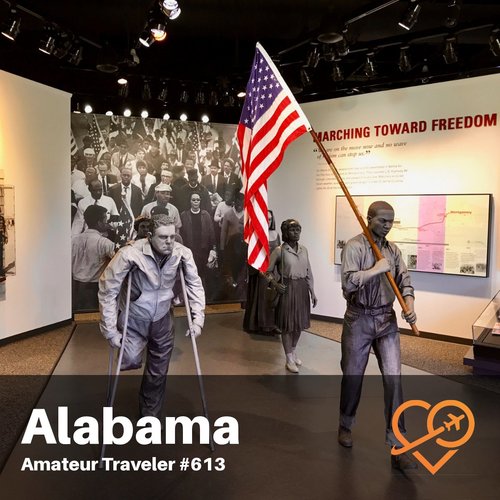After the success of our Great American Road Trip to the heart of the United States a couple of years ago, I was excited to turn a trip to Huntsville Alabama to a larger road trip to Deep South America: Alabama and Mississippi (with a stop at a UNESCO World Heritage site in Louisiana).
Table of contents: ()

I was in Huntsville Alabama for the TBEX North America conference. I had a chance to do a press trip afterward down to Gulf Shores Alabama.
Gulf Shores
Gulf Shores is an area with long beautiful white sand beaches, a surprisingly good small zoo, some great opportunities for watersports, and other outdoor recreation. Besides biking, boating, sailing, and lots of eating, I also had a chance to visit Fort Morgan State Park which was the site of the Battle of Mobile Bay in the Civil War. Read more about my visit to Gulf Shores in these detailed posts:
Alabama National Parks
After the press trip to Gulf Shores ended, I had two days to make it back to Huntsville Alabama to meet up with my wife and decided to spend it exploring Alabama’s National Parks.
Selma To Montgomery National Historic Trail
I grew up in the 1960s. The civil rights movement was on the nightly news when I was a kid. As someone who grew up way out in California the problems the United States was having at the time in the South made little sense to me, so I was excited to visit this national historic trail that spans the route from Selma to Montgomery Alabama.
On March 7, 1965, an estimated 500-600 civil rights marchers headed from Selma on U.S. Highway 80, heading towards the state capitol in Montgomery to protest illegal restrictions on their right to vote. The marchers encountered Sheriff Jim Clark and a crowd of recently deputized white men at the Edmund Pettus Bridge. When the marchers failed to disperse the Sheriff’s men attacked in what became known as “Bloody Sunday”. 17 marchers were hospitalized. All of this was captured by TV cameras. A second march later in the month was also turned around and led to the death of one protester.
The civil rights marchers regrouped, organized, and persisted. A third march was protected by the Alabama National Guard, which President Johnson decided to federalize. This park commemorates the struggle and eventual victory of these protests.
I didn’t stop and every marker along this route but stopped at the visitor center halfway along which tries to explain the story.
This park is relatively new, having been created in 1996. The visitor center is small but modern. It uses a lot of videos to talk about the civil rights march from Selma with many of the clips coming from the nightly news I grew up watching. The museum introduces the main actors, both those organizing the march and those opposing it.
Tuskegee Airmen National Historic Site
Near the town of Tuskegee, Alabama, the United States somewhat reluctantly conducted a controversial experiment in World War II. The Army Air Corps (the precursor to today’s Air Force) was not convinced that a “Negro” man had the capacity to learn to be a pilot. The Army was not at first interested in putting this thesis to the test with its precious airplanes until forced to by political pressure.
They chose an airfield near the Tuskegee Institute for this experiment. The Tuskegee Institute was founded by George Washington Carver as one of the first universities in the south to teach African Americans. The Tuskegee Institute is itself a national historic site, although I did not have time to visit it on this trip.
Black men came from all over the U.S. to Tuskegee to learn to become pilots. For some, it was their first trip to the deep South. They likely had experienced prejudice before, but some had not experienced the Jim Crow laws enforced in the South that was separate and unequal. The museum talks about how the pilots had to fight on two fronts. They fight against fascism abroad and racism at home.
Not only could a black man learn to fly, he could learn to fly well. One pilot instructor at a different training facility would later comment about Tuskegee, “we were graduating men that Tuskeegee would have failed”. The officers at Tuskegee do that just to be competent would not be good enough. The United States was reluctant to deploy these new pilots, until Eleanor Roosevelt took a flight with one in a training plane, and made it very awkward for anyone in the army to claim these Tuskegee airmen were unqualified.
When they were finally deployed to North Africa and later to Italy they were deployed in segregated squadrons. The most well-known of these was the 332nd Fighter Group whose planes were easily identifiable by their red tails. This squadron was tasked with escorting American bombers on raids deep into Germany. They distinguished themselves and their success led eventually to the bomber pilots of all-white units requesting specifically to be escorted by the “Red Tail Angels”.
This museum will take about two hours and uses lots of videos to let the Tuskegee airmen explain their story in their own words. The story continues after the war when the performance of the Tuskegee airmen led in part to Truman’s order to desegregate the armed forces.
Freedom Riders National Monument
Getting back to a civil rights theme, I wanted to visit the Freedom Riders National Monument in Anniston, Alabama.
In 1961 groups of civil rights activists challenged “Jim Crow” segregation laws on buses and in bus stations in the south. Stations had separate restrooms, waiting rooms, and lunch counters for blacks and whites. The United States Supreme Court had ruled this segregation to be illegal on two occasions but this was not being enforced in the South.
A group of “Freedom Rides” was organized by the Congress of Racial Equality (CORE) and the Student Nonviolent Coordinating Committee (SNCC). Integrated groups of riders would challenge these laws. They would sit together with at least one black person sitting in the front of the bus where they were not allowed by local custom.
Violence broke out when a mob of KKK members attacked a bus at the Greyhound station in Anniston. They blocked its exit and slashed the bus tires. Sheriff deputies came in but only “protected” the bus as far as the city line. Crowds put up with the buses caught up with the Greyhound bus, lit it on fire with a molotov cocktail, and beat the activists as they came off the bus. An hour later when a Trailways bus arrived in town, 8 KKK members came on the bus, beat the Freedom Riders, and left them semi-unconscious.
More rides and more violence happened throughout the South in the Summer of 1961. Pressured by the Kennedy White House, on November 1, 1961, the Interstate Commerce Commission used its authority over interstate commerce to desegregate long-haul buses like Greyhound and Trailways.
The Freedom Riders National Monument is a bit off the beaten path, and while I recommend reading up on the story, I can’t quite recommend the site as it is still under development. It has no visitors center yet and all that I could find was some information on the old Greyhound depot. What signage is there today, does a good job of telling the story, but I wouldn’t go out of my way to see it until such time as they build a visitor center. A project which seems unlikely in the current political climate.
Montgomery Alabama
Stop in the capital of Montgomery to visit some iconic Montgomery civil rights sites like the Rosa Parks Museum or the Dexter Avenue King Memorial Baptist Church. Or visit the Legacy Museum and National Memorial to Peace and Justice (lynching memorial) which were created by the Equal Justice Initiative.
While you are there if the Montgomery Biscuits are in town, take in a ballgame at one of the better minor league ballparks in the United States.
Read more at:
- 11 Things to Do in Montgomery Alabama
- Montgomery, Alabama – Civil Rights, Slavery, Lynching and the Legacy Museum (Video #98)
- 16 Great Places to Eat or Drink in Montgomery Alabama
Huntsville Alabama

You can still see one of three existing Saturn V rockets hanging from the ceiling of the U.S. Space & Rocket Center here. While you’re looking at it don’t be too surprised if a retired rocket scientist turned docent walks up because “his wife wants him to get out of the house”. He probably worked on the very piece of the rocket that you were looking at and can explain it in detail. Next door to the museum is Space Camp.
Huntsville also has a thriving arts scene and the largest private art space in the country at the converted cotton mill Lowe Mill. It is a great food scene, beautiful botanical gardens, and a collection of antebellum homes. See more about Huntsville and my posts:
- Huntsville, Alabama – The Rocket City and More (Video #88)
- “Huntsville, Alabama TBEX Preview Trip” – This Week in Travel #212
Natchez Trace Parkway
As Tennessee Alabama and Mississippi were being settled by European settlers, they used an old Indian trading route from Nashville, Tennessee to Natchez, Mississippi, on the Mississippi River. That trading route is now the Natchez Trace Parkway, a beautiful road run by the National Park Service. The parkway is a swath of green parkland that runs for 444 miles. We drove west from Huntsville and picked up the Natchez Trace towards the city of Vicksburg, Mississippi.
Along the way, we stopped at the visitor center to learn about the history of this route. We also stopped at a nature trail through swampland and at some of the Indian burial mounds along the route. There are no services along the route that we saw, but there is a listing of nearby gas, drinking water and local markets organized by different mileage markers. This is not the fastest route through the state, but probably the prettiest.
Vicksburg Mississippi
As a history buff and a Civil War history buff, in particular, I have been trying to get to Vicksburg Mississippi for a few years. The siege of Vicksburg in 1863 was a major turning point of the Civil War. Its capture allowed the union to control the Mississippi from its headwaters to the Gulf of Mexico which cut the Confederacy in half.
The Vicksburg National Military Park commemorates the battle and those who fought here. One of the more interesting features of the park is the U.S.S. Cairo that is an old Union ironclad gunboat that was sunk during the battle but raised from the muddy waters, largely preserved, in 1965.
Vicksburg seems to me to be a town on the rise after some difficult years. We enjoyed visiting its museum about the Lower Mississippi River. The museum is run by the Army Corps of Engineers which has a base here in Vicksburg. The museum focuses on the Corps’ work on navigation and flood control of the lower Mississippi River. We also enjoined a visit to the Old Courthouse Museum and to some of the wonderful restaurants in town.
Read more about our Vicksburg visit at these posts:
Poverty Point National Monument
The best flights we could find were not out of Vicksburg but out of Little Rock, Arkansas, So we drove from Vicksburg through Louisiana and Arkansas to catch a flight.
Along the way, we stopped at a UNESCO World Heritage Site named Poverty Point. The site is a national monument run by the Louisiana State Park System.
Poverty Point is a series of Indian mounds, not burial mounds, but built probably created for some ceremonial purpose. If the mounds don’t look spectacularly impressive, then you’ve missed the point that they were built in a short period of time by Native Americans using little more technology than reed baskets. If you’re in the area Poverty Point is a very interesting stop that will take you an hour to see by car or longer if you walk the trails instead.
Great American Road Trip
It Little Rock was one of the places that we visited on our Great American Road Trip which included Kansas City, Little Rock, Memphis, Nashville, Louisville, and Cincinnati. If you want to continue the drive from Little Rock check out more information about that trip.
The American South
I’m not sure what I expected from the American South, but most of it was very familiar. There are certainly familiar restaurants and stores. Alabama, in particular, is much prettier than I think I expected. It is very green, and quite beautiful on a warm late spring day. The other states were also beautiful although they may look a little more economically challenged in the rural areas.
We did see some evidence of the difficulties that some rural towns are having when we stopped in Eudora, Arkansas. The grocery store downtown was almost the only building not boarded up on the main street and it had signs declaring it was not going out of business because it totally looked like it was going out of business.
Surprises
Every once in a while, we saw something that made us do a double-take. I had to stop when I saw the signs for a haunted chicken house in Helfin, Alabama. We also saw signs for two different coon dog cemeteries. We don’t have those at home and that, of course, is the reason I like a good road trip.

+Chris Christensen | @chris2x | facebook
One Response to “Deep South, America Road Trip – Alabama, Mississippi and Louisiana”
Leave a Reply
Tags: alabama, article, featured, louisiana, mississippi, national park, road trip

















 What to See and Do in Vicksburg, Mississippi – Deep South Road Trip
What to See and Do in Vicksburg, Mississippi – Deep South Road Trip Travel to Alabama – Episode 613
Travel to Alabama – Episode 613 Where to Eat in Vicksburg, Mississippi
Where to Eat in Vicksburg, Mississippi Montgomery, Alabama – Civil Rights, Slavery, Lynching and the Legacy Museum (Video #98)
Montgomery, Alabama – Civil Rights, Slavery, Lynching and the Legacy Museum (Video #98)


Bryan Johnson
Says:August 2nd, 2019 at 2:36 pm
Great blog, man. I really want to check out the freedom riders now.
Bryan Johnson